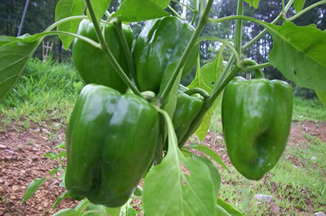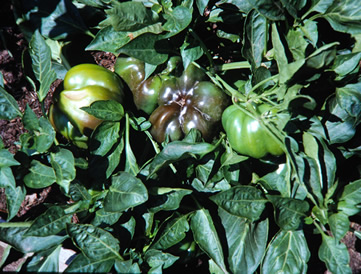Pepper
Most pepper breeding for large production areas of the US has been in California, Florida and New Jersey. Recently breeders in more adverse climatic areas, for peppers, such as Maine and Texas have developed varieties adapted to their climates. A variety's performance can vary widely, depending on where it is grown.
Peppers are classified as a warm season crop, but their heat requirement is not as high as you might expect. Fruit set occurs in a limited range of night temperatures. Blossoms drop when night temperatures are just below 60 degrees Fahrenheit, or above 75 degrees F. Daytime temperatures above 90 degrees F. will cause excessive blossom and fruit drop. Small-fruited varieties are more tolerant of high temperatures than varieties with large fruit. Peppers also have a stress relief habit of dropping their smaller fruit when overloaded. When some of the peppers are harvested, the plant will again set fruit...if the weather is right.

Coastal gardens with their moderate temperatures have only minor cultural problems in growing peppers. Wind-free, sun pockets in the garden are ideal areas for sweet peppers. Inland, an artificial mini-climate can be beneficial if the garden is hot and dry.
SOIL PREPARATION:
A well-drained soil with organic matter added will keep the soil moisture even and minimize blossom drop. Work in a complete fertilizer before planting. Peppers do very well with drip irrigation and mulch.
START SEEDS in pots seven to ten weeks before transplanting to the garden. Germination and seedling growth need bottom heat about the same as tomatoes (72 to 80 degrees F.) for germination and 65 to 75 degrees F. for growth, with plenty of bright light. Seedlings need a larger growing space after the first set of true leaves form. After repotting, feed weekly with a solution of diluted fish emulsion. Don't set plants out in the garden until weather is warm (night temperatures above 60 degrees F.) or use floating row covers. Small plants do very well under cover for 3 to 4 weeks. Row covers also keep plants insect free until they are well established.
PLANTING TIPS:
Peppers will do very well for 2 months under floating row covers. Plants need sun, but in inland valleys they do better with a little afternoon shade to help prevent sun-burning. They also do better planted together in blocks where foliage shades the ground and provides a cool humid environment at ground level and between the plants. If you are in a windy area, protect plants with shade cloth on the windy side. A frame with shade-cloth or row-cover fabric over the top can also reduce high light intensity in mid to late summer. Mulch ground to keep soil cool and evenly moist. Peppers get blossom-end rot like tomatoes. Keeping even soil moisture corrects this problem. Peppers do very well on drip irrigation.
PESTS AND DISEASES:
Tobacco mosaic is the most damaging disease of peppers, as it stunts plants and the increased stress will result in very small yields for such a long season crop. If tobacco mosaic virus is a problem in your garden, plant resistant varieties for your main crop. The tobacco mosaic virus is usually transmitted by aphid and leafhoppers. It can also be transmitted mechanically (by hand) from plant to plant and from other solanaceous plants (tomato, eggplant, potato). A mulch of aluminum foil under newly transplanted plants will effectively keep leafhoppers and aphids off of the plants.
Pepper weevils are occasional pests. Sanitation is important to control the pest. All dropped fruit must be picked up and disposed of in trash bags, as the fruit contains the larva of the adult weevil.
One of the more common problems in inland areas is sunburn of the fruit during hot spells. A piece of shade-cloth or row-cover fabric such as Reemay will provide enough shade in the heat of the day to protect fruit from sun burn. Large fruit varieties will cause the plant to open up from the weight of the peppers on the outer branches. Use the cone-shaped wire tomato type cages over the young plants for support.
VARIETIES: (see catalogue sources 2010)
Some of the All American winners for sweet peppers have been very productive and of consistent high quality. GYPSY, an '80s introduction is early, crisp, tapered fruit that turns from yellow to orange. It is also tobacco mosaic resistant. There are two different types of peppers in the yellow or golden bell class:
- Hungarian strains change color more uniformly from pale green/butter yellow & orange red. They are usually more of a tapered bell shape and have thicker walls, mature earlier and are very sweet.
- United States or Dutch strains ripen in streaks or blotches from dark green/gold/dark red and the shape is blockier. They mature later and the taste is not as sweet.
For many years the commercial varieties developed in California like YOLO WONDER and CAL-WONDER have been used by backyard gardeners. Gardeners should try some of the newer hybrids: BELL BOY HYBRID, 72 days; BIG BERTHA, 72 days; BURPEES EARLY PIMENTO, 75 days; GOLDEN SUMMER HYBRID, 67 days; and SWEET CHOCOLATE, 58 days tolerates cool nights. *Thompson and Morgan carries a mixed seed packet of hybrid sweet peppers that come in yellow, red, green and purple. Stokes Seeds has an Italian type called CUBANELLA, a sweet frying type.

HOT PEPPERS or chilies are a confused group. The problem arises from the more than 100 varieties and they all cross-pollinate. Another peculiarity is when a chili is grown in a moderate climate, the fruit can be mild, but if grown in a more stressful climate or condition the same variety can be very HOT! New Mexico State University has developed some mild chilies. BIG JIM is a thick walled long green Anaheim type chili used for stuffing or dried & powdered. NUMEX 'R. NAKY' is a mild chili similar to BIG JIM and prolific. MEXIBELL is a chili flavored bell pepper cross.
Hotness in chilies depends on three factors.
- Weather...hot weather promotes hot peppers due to stress which slows growth. Low soil moisture and lack of nitrogen and pests also slow growth and make peppers hotter.
- Variety...among chilies, some varieties are known for their fire which is due to their genetics.
- Maturity at time of harvest...Capsaisin the chemical responsible for the hot sensation begins to develop about 4 weeks after fruit has set and continues as the fruit matures. The 'heat' is in the seed and interior ribs.
PEPPER GROWING TIPS:
For a second harvest of peppers in the fall, pinch off side branches and flowers of the plant after the first harvest to make a sturdy plant. This forces plants to branch lower and to flower toward the inside of the plant where the fruit is protected from sunburn.
Then fertilize each plant with 2 tablespoons of fish emulsion per gallon of water. When fruits are about 1/4 inch in size, thin (pinch off) some fruit leaving about 8 peppers per plant to mature. Light applications of fertilizer may be applied to growing plants when 6 to 8 inches tall and again after fruit set. Keep peppers picked or they will stop producing flowers. The crown set usually produces the largest first pepper. This pepper should be picked just as it reaches full size or it will get pinched in the middle of the plant and force the plant to an open growth pattern in the center and subsequent sunburn of later fruit. (The first set of buds, crown-set, occurs at the node where the second stems branch from the main stem.)
Also check out ...
UC websites for the Vegetable Research and Information Center (http://vric.ucdavis.edu) and Integrated Pest Management (www.IPM.ucdavis.edu)
Planting Dates
Coastal:
April - June
Inland:
April - July
Varieties
JEWEL TONE SWEET BELLS (Ariane) an orange colored bell type, sweet pepper.
MEXIBELL a bell type with chili cross, Stokes seed, 58 - 75 days
PURPLE BEAUTY bell type, open pollinated, 70 days. Very prolific, but fruit sunburns if plant opens. Prune as described above.
GIANT SZEGEDI top shaped, sweet frying pepper 70 days, yellow from Stokes Seed. Start early under row-covers. Fruit gets small as heat builds up in late summer.
SUPER RED PIMENTO flat shaped, sweet, 70 days. Stokes Seed. Very prolific, thick walls, good flavor.
Seed Suppliers:
- Thompson and Morgan: www.tmseeds.com
- Stokes Seeds: www.stokesseeds.com
- Renee's Garden Seeds: www.reneesgarden.com
- Nichols seeds: www.nicholsgardennursery.com
- Totally Tomatoes: www.totallytomato.com
- Park Seeds: www.parkseed.com
- Burpee Seeds: www.burpee.com
- Territorial Seed Co: www.territorialseed.com
- Baker Creek Heirloom Seeds: http://rareseeds.com
New varieties are developed yearly and names in catalogs change as these new introductions appear and old ones are dropped. All American Selections (AAS) are held for several years and can be found year after year.

